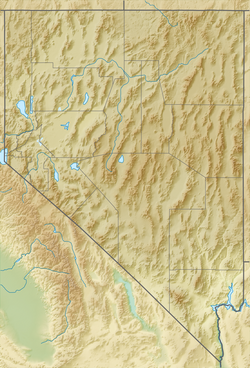Northern
In the northern portion of the McCullough Range elevation spans from 2,000 ft (610 m) at the eastern base of the range to 5,092 ft (1,552 m) at Black Mountain. The peaks are volcanic in origin, rounded to flat-topped, and have a steep eastern escarpment and a gradual western slope. The area supports a unique combination of plants from the Mojave and Sonoran deserts and Great Basin Desert ecosystems.
The primary vegetation is a creosote bush community with barrel cactus (Ferocactus cylindraceus), Joshua trees (Yucca brevifolia), various chollas (Cylindropuntia spp.) and prickly pears (Opuntia spp.). Unlike other mountain ranges in Clark County, the McCullough Range is volcanic in origin. Examples of lava flows, ash falls and glassy zones are clearly visible. The area supports native black gramma grass (Bouteloua eriopoda), which is not known to occur anywhere else in Nevada and stands of teddy bear cholla (Cylindropuntia bigelovii), which is the northernmost extent of the species. Remarkable petroglyph panels and other important cultural resource features occur within the wilderness area. [5]
Another peak northeast of Black Mountain is home to most of the radio and television transmission towers for the Las Vegas Valley.
Southern
The southern portion consists of a north–south mountain range that drops off gradually to numerous valleys, foothills and sloping bajadas on the east and west flanks. Elevations range from 2,500 ft (760 m) in the northwest portion of the area to 7,026 ft (2,142 m) at McCullough Mountain in the center of the wilderness. Most of the area is composed of metamorphosed Precambrian rock, granite, and schist, although basalt and andesite flows occur in the northern reaches of the southern portion. Creosote bush (Larrea tridentata) scrub occurs below 4,500 ft (1,400 m); Joshua trees, Mojave yucca (Yucca schidigera), and other cacti occur between 3,500–5,000 ft (1,100–1,500 m); blackbrush occurs between 4,500–5,000 ft (1,400–1,500 m); pinyon-juniper occurs above 5,000 ft (1,500 m). Scattered mesquite/catclaw communities also occur in washes throughout the area.
Signs of prehistoric and Pre-Columbian habitation have been found in the area, including rock art, occupation and settlement sites, and pinyon pine nut caches. This was part of the historic homeland of the Mojave people.
The desert tortoise, Nelson bighorn sheep, Gambel's quail and chukar are present. [1]

